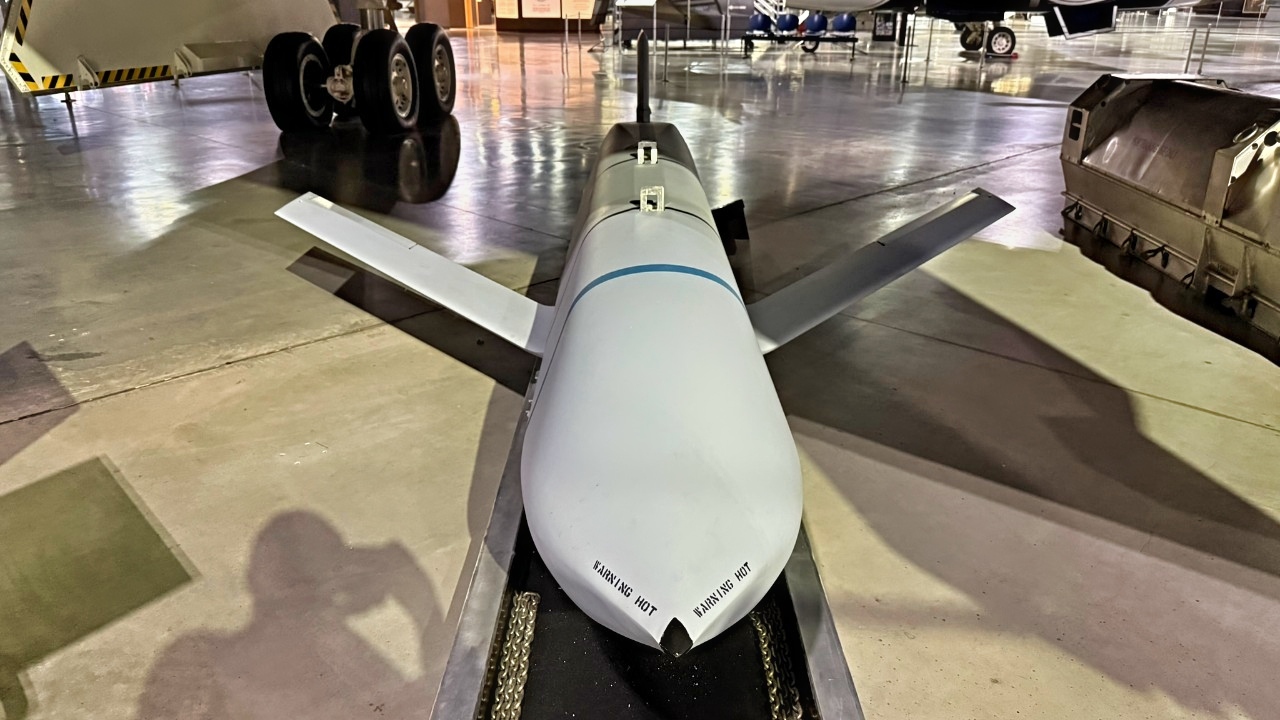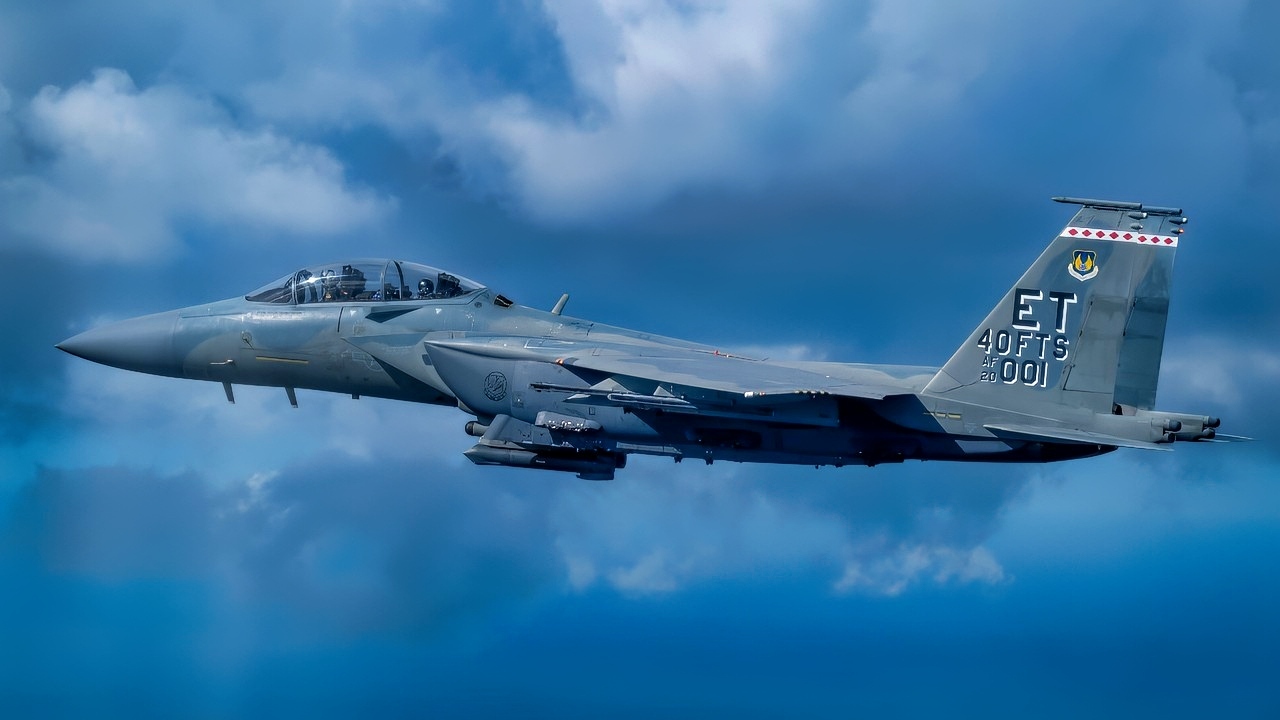Key Points and Summary – The F-15EX Eagle II arrived with baggage: critics say it’s not stealthy and therefore not future-proof.
-Yet the jet solves real Air Force problems right now.

An F-15EX Eagle II, assigned to the 142nd Wing, taxis on the flightline before take-off during the official Unveiling Ceremony for the new fighter jet at the Portland Air National Guard Base, Oregon on July 12, 2024. The 142nd Wing will be replacing the F-15 C/D model Eagles with the new F-15EX Eagle II models. (National Guard photo by John Hughel, Oregon Military Department Public Affairs)

A U.S. Air Force F-15EX Eagle II, assigned to 85th Test and Evaluation Squadron, Eglin Air Force Base, Florida, lands at Kadena Air Base, Japan, July 16, 2025. The F-15EX plays a critical role in modern warfare, providing substantial additional capacity for long-range fires, sensors, and electronic warfare in contested areas, complementing 5th generation fighters. (U.S. Air Force photo by Airman Nathaniel Jackson)
-It hauls an unmatched weapons load, flies fast and far, carries modern sensors that can spot hard-to-see targets, and adds a deep, software-driven upgrade path.
-It also slips into existing F-15 units with minimal upheaval, giving the force more combat-ready tails without a painful transition.
-No, it won’t replace fifth-generation stealth fighters—but it was never meant to.
-As a magazine, quarterback’s aide, and hypersonic hauler, the Eagle II gives the Air Force options it otherwise lacks.
Why The F-15EX Eagle II Still Matters: 5 Reasons This Plane Is Needed
Start with the awkward truth: the F-15EX isn’t a stealth fighter.
It won’t be the first jet through the densest modern air defenses. But that isn’t its job. The Eagle II exists to do everything our stealth jets shouldn’t be doing—lugging enormous arsenals, staying on station a long time, and acting as a resilient, upgradeable “payload truck” that can fight tonight while the force buys time for sixth-generation programs to mature.
If you judge the EX against an F-22 or F-35 on low observability alone, you’ll miss the point. Judge it on what the Air Force needs most in 2025 and beyond: capacity, range, magazine depth, and the agility (technical and bureaucratic) to integrate new weapons quickly. On those metrics, the Eagle II is a quietly radical choice.
Below are the five features that make the case.
Magazine Depth You Can Actually Use
The F-15 airframe has always been about energy and payload. The EX doubles down on that heritage with strengthened structure, new mission computers, and modern pylons that let it carry a fearsome mix of air-to-air and standoff air-to-surface weapons.
In air-superiority loadouts, it can tote a dozen radar-guided missiles—enough to escort, sanitize, and still retain shots for the ride home. Swap those for long-range cruise missiles like JASSM-ER or anti-ship weapons, and it morphs into a long-reach strike partner for stealth jets.

JASSM Missile National Security Journal Original Photo. All Rights Reserved.

JASSM ‘Stealth’ Cruise Missile. Image Taken by National Security Journal at the U.S. Air Force Museum on 7/19/2025.
This is what “magazine depth” looks like in practice: a fighter that brings its own arsenal and doesn’t need constant topping-off from scarce bombers or surface shooters. In a Pacific scenario where distances are brutal and tankers are at risk, moving more missiles per sortie is not a luxury; it’s a survival trait.
Just as important, the EX gives the Air Force a fast path to integrate new munitions. The jet’s power, ground clearance, and centerline station make it a natural candidate for outsized stores that won’t fit cleanly inside stealth jets. That means when a next-generation weapon arrives—think new anti-ship missiles, stand-in jammers, or future air-breathing hypersonics—the EX can be among the first fighters to carry it at real-world ranges.
Speed And Reach Buy Time And Options
The F-15EX Eagle II retains the F-15’s calling cards: high-altitude performance and serious dash speed, as in Mach 2.5.
That’s not just a pilot’s brag; it’s tactics. Speed lets you reposition quickly to protect a tanker track, sprint to a standoff launch point, or surge across a theater to backstop a threatened ally. Altitude and energy also translate into missile kinematics—your weapons simply perform better when they start higher and faster.
Range matters, too. Conformal tanks and efficient engines keep the EX on station longer, reducing the Air Force’s tanker bill and exposure. In a conflict where refuelers, forward airfields, and logistics nodes will be prime targets, jets that can loiter and fight without guzzling tanker gas are worth their weight in options.
Sensors That See What Stealth Hides
Modern air combat is a sensing contest: who detects whom first, and who can shoot without being seen. The F-15EX Eagle II’s radar, infrared search-and-track, and electronic-warfare suite were chosen with that reality in mind.

A U.S. Air Force F-15EX Eagle II fighter jet assigned to Eglin Air Force Base, Florida, flies near Jacksonville, Florida, Nov. 2, 2024. Airmen from the 40th Flight Test Squadron and 96th Aircraft Maintenance Unit supported a flyover for the annual Florida-Georgia college football game. (U.S. Air Force photo by Staff Sgt. Blake Wiles)

The Air Force’s newest fighter, the F-15EX Eagle II, was revealed and named during a ceremony April 7 at Eglin Air Force Base, Fla. The aircraft will be the first Air Force aircraft to be tested and fielded from beginning to end, through combined developmental and operational tests. (U.S. Air Force photo/Samuel King Jr.)
A powerful active electronically scanned array (AESA) radar provides range, tracking stability, and resistance to jamming. An infrared search-and-track (IRST) pod adds a passive way to find and target aircraft that try to minimize their radar signature. And the EPAWSS self-protection system layers in threat warning, geolocation, and countermeasures that adapt as the environment changes.
One platform won’t win every sensing fight. But the EX’s mix—active radar reach, passive infrared stalking, and smart defensive tools—lets it hunt and survive against the kinds of adversaries it’s most likely to meet: cruise-missile carriers, non-stealth fighters, and long-range shooters hiding behind jammers. Perhaps more importantly, those sensors make the EX a multiplier. It can spot, sort, and pass targeting data to stealth teammates, ground batteries, or surface combatants, making everyone’s weapons smarter.
Built To Upgrade, Not Age
A big lesson from the last two decades is that software beats hardware time after time. The F-15EX was designed around that reality, with a modern computing backbone and open-systems architecture that welcomes new apps, sensors, and weapons without rewriting the airplane’s DNA.
In practical terms, this means the F-15EX Eagle II can field new threat libraries, datalinks, and weapons integration on shorter timelines. The “all-glass” cockpit and large-area displays are more than eye candy; they make it feasible to add complex capabilities without burying the pilot under buttonology. And the life-of-type goal—roughly 20,000 flight hours—means upgrades are amortized over decades, not a few short years.

Two U.S. Air Force F-15EX Eagle IIs assigned to the 85th Test and Evaluation Squadron, Eglin Air Force Base, Florida, taxi after landing at Kadena Air Base, Japan, July 16, 2025. Local units conducted integration and familiarization training with the F-15EX. (U.S. Air Force photo by Airman 1st Class Arnet Shayne Tamayo)
That’s the quiet genius of the jet: it’s a stable, roomy, power-rich platform that treats software like a first-class citizen. When the Air Force decides to push a hypersonic missile, a collaborative drone control app, or a better radar mode, the EX is ready to absorb it.
A Low-Drama Transition For A Stressed Force
Fleet recapitalization usually hurts. New jets need new hangars, new tools, new training pipelines, and years of tactical re-learning. The Eagle II dodges much of that pain by sliding into existing F-15 squadrons. Pilots and maintainers already speak “Eagle.” Bases already have the right ramps, weapons elevators, and tech data. That continuity shortens the road from delivery to deterrence.
It also de-risks the broader force. The Air Force is juggling stealth-fighter sustainment, a once-in-a-generation bomber program, next-gen air dominance, and a munitions renaissance. The EX doesn’t compete with those; it buys breathing room for them. It backfills air-defense and homeland missions, augments tanker escort and cruise-missile defense, and shows up with a war-sized weapons load when stealth jets need a heavy hitter behind them.
In other words, the Eagle II isn’t a step backward from stealth. It’s a step sideways that gives the force more shoulders to lean on while the next leap forward takes shape.
So, Did The Air Force Undervalue The EX?
Early debates tended to frame the F-15EX Eagle II as a false choice: buy stealth or buy Eagles. That binary never matched reality. The Air Force needs both. It needs stealth to kick down the door, and it needs magazine depth to keep the door from swinging back. It needs exquisite and it needs enough.
If there was a mistake, it was treating the EX as a temporary patch or a political compromise rather than what it actually is: a flexible, affordable accelerant to the rest of the force. The longer the Air Force flies it, the clearer that becomes. When future weapons arrive—the kind that stress power, space, and payload—the Eagle II will be one of the few fighters that can carry them in useful numbers.
No, it won’t glide unseen through the heart of an integrated air-defense system. It doesn’t have to. It only has to show up with a lot of reach, a lot of missiles, and a lot of ways to make everyone around it better. That’s the job description—and the EX does it well.
The Bottom Line on F-15EX Eagle II
The F-15EX won’t star in a stealthy opening night—but it will headline night two, night three, and the long grind after that. It gives the Air Force something precious in a dangerous decade: capacity with teeth, on a platform that can grow.
If the service leans into its strengths—big weapons loads, fast integration of new missiles, and a role as a sensor-and-shooting multiplier—the Eagle II will prove that “not stealthy” and “not relevant” are not the same thing.
About the Author: Harry J. Kazianis
Harry J. Kazianis (@Grecianformula) is Editor-In-Chief and President of National Security Journal. He was the former Senior Director of National Security Affairs at the Center for the National Interest (CFTNI), a foreign policy think tank founded by Richard Nixon based in Washington, DC. Harry has over a decade of experience in think tanks and national security publishing. His ideas have been published in the NY Times, The Washington Post, The Wall Street Journal, CNN, and many other outlets worldwide. He has held positions at CSIS, the Heritage Foundation, the University of Nottingham, and several other institutions related to national security research and studies. He is the former Executive Editor of the National Interest and the Diplomat. He holds a Master’s degree focusing on international affairs from Harvard University. Email Harry: [email protected].
More Military
Why the U.S. Navy Finally Said No to the F-14 Tomcat
Israel’s Merkava Tanks Have a Message for Any Army On Earth
The Mach 1.4 X-59 Could Create Military Nightmares for Russia and China










